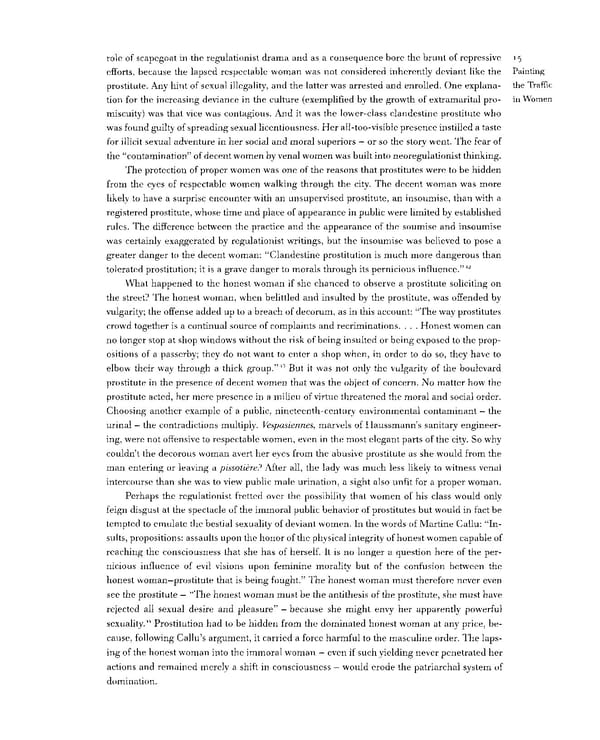role of scapegoat in the regulationist drama and as a consequence bore the brunt of repressive 15 efforts, because the lapsed respectable woman was not considered inherently deviant like the Painting prostitute. Any hint of sexual illegality, and the latter was arrested and enrolled. One explana- the Traffic tion for the increasing deviance in the culture (exemplified by the growth of extramarital pro- in Women miscuity) was that vice was contagious. And it was the lower-class clandestine prostitute who was found guilty of spreading sexual licentiousness. Her all-too-visible presence instilled a taste for illicit sexual adventure in her social and moral superiors — or so the story went. The fear of the "contamination" of decent women by venal women was built into neoregulationist thinking. The protection of proper women was one of the reasons that prostitutes were to be hidden from the eyes of respectable women walking through the city. The decent woman was more likely to have a surprise encounter with an unsupervised prostitute, an insoumise, than with a registered prostitute, whose time and place of appearance in public were limited by established rules. The difference between the practice and the appearance of the soumise and insoumise was certainly exaggerated by regulationist writings, but the insoumise was believed to pose a greater danger to the decent woman: "Clandestine prostitution is much more dangerous than 42 tolerated prostitution; it is a grave danger to morals through its pernicious influence." What happened to the honest woman if she chanced to observe a prostitute soliciting on the street? The honest woman, when belittled and insulted by the prostitute, was offended by vulgarity; the offense added up to a breach of decorum, as in this account: "The way prostitutes crowd together is a continual source of complaints and recriminations. . . . Honest women can no longer stop at shop windows without the risk of being insulted or being exposed to the prop- ositions of a passerby; they do not want to enter a shop when, in order to do so, they have to 43 elbow their way through a thick group." But it was not only the vulgarity of the boulevard prostitute in the presence of decent women that was the object of concern. No matter how the prostitute acted, her mere presence in a milieu of virtue threatened the moral and social order. Choosing another example of a public, nineteenth-century environmental contaminant — the urinal — the contradictions multiply. Vespasiennes, marvels of Haussmann's sanitary engineer- ing, were not offensive to respectable women, even in the most elegant parts of the city. So why couldn't the decorous woman avert her eyes from the abusive prostitute as she would from the man entering or leaving a pissotiere? After all, the lady was much less likely to witness venal intercourse than she was to view public male urination, a sight also unfit for a proper woman. Perhaps the regulationist fretted over the possibility that women of his class would only feign disgust at the spectacle of the immoral public behavior of prostitutes but would in fact be tempted to emulate the bestial sexuality of deviant women. In the words of Martine Calm: "In- sults, propositions: assaults upon the honor of the physical integrity of honest women capable of reaching the consciousness that she has of herself. It is no longer a question here of the per- nicious influence of evil visions upon feminine morality but of the confusion between the honest woman—prostitute that is being fought." The honest woman must therefore never even see the prostitute — "The honest woman must be the antithesis of the prostitute, she must have rejected all sexual desire and pleasure" — because she might envy her apparently powerful 44 sexuality. Prostitution had to be hidden from the dominated honest woman at any price, be- cause, following Callu's argument, it carried a force harmful to the masculine order. The laps- ing of the honest woman into the immoral woman — even if such yielding never penetrated her actions and remained merely a shift in consciousness - would erode the patriarchal system of domination.
 Prostitution & Impressionists Page 35 Page 37
Prostitution & Impressionists Page 35 Page 37